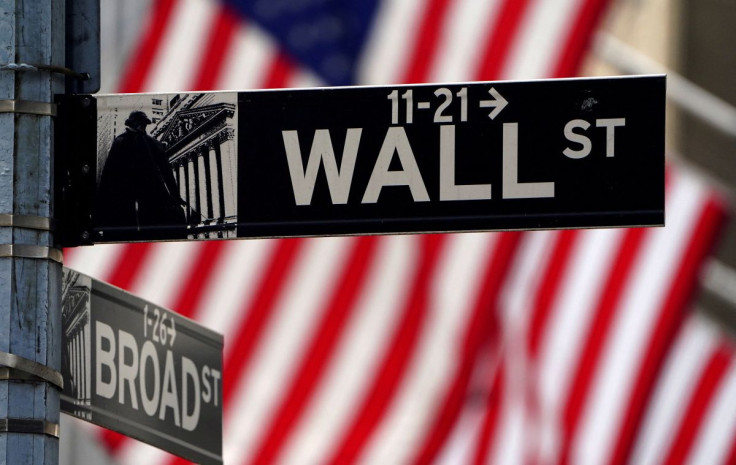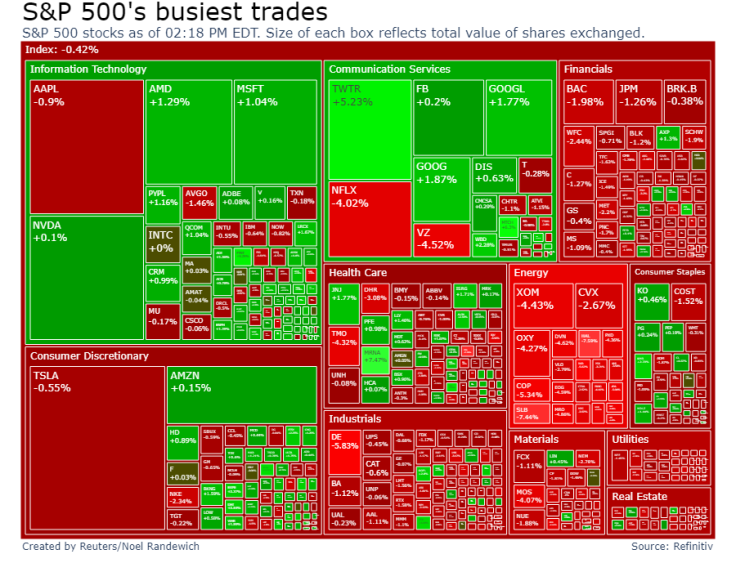Wall Street Mixed As Twitter Agrees To Be Bought By Musk

Wall Street was mixed Monday, with investors worrying about rising interest rates and China's COVID-19 outbreaks, while Twitter gained after agreeing to be bought by Elon Musk.
Helping lift the Nasdaq, Twitter was up 5.7% after announcing it would be bought by Musk in a deal that will shift control of the social media platform to the world's richest person.
Uncertainty reverberated across world markets, with Chinese shares marking their biggest slump since a pandemic-led selling in February 2020 and European stocks falling to their lowest in over a month on fears of strict restrictions in China. [MKTS/GLOB]
Most of the major S&P sectors fell, with the energy index tumbling over 3% as Brent crude prices dropped almost 5% toward $100 a barrel. [O/R]
Oil majors Chevron Corp and ExxonMobil fell more than 2% each, while oilfield services companies Schlumberger NV and Halliburton Co dropped more than 6% each.
Google-owner Alphabet rose 1.8% ahead of its quarterly report after the bell on Tuesday.
Nearly a third of S&P 500 index firms are due to report this week. Of the 102 companies in the S&P 500 that posted earnings so far, 77.5% reported above analysts' expectations, according to Refinitiv data.
"Earnings are going to be crucial to the mindset of the of the average investor. The playbook was buy Apple, buy Netflix, buy Google and throw away the key, but that playbook is no longer working," said Jake Dollarhide, chief executive officer at Longbow Asset Management. "What is the outlook for these companies going to be?"
The CBOE Volatility index, known as Wall Street's fear gauge, hit as high as 31.6 points, its highest level since mid-March.
Investors were also on edge at the start of a week that will see megacap companies like Google-parent Alphabet Inc, Microsoft Corp, Amazon.com Inc and Apple Inc publish quarterly results.
Bleak results from pandemic darling Netflix along with surging bond yields pummeled high-growth stocks last week, bringing year-to-date losses in the tech-heavy Nasdaq to about 18%.
Traders are pricing in big moves by the Fed this year to control inflation after a series of hawkish remarks from policymakers. Fed Chair Jerome Powell last week gave a "go" sign to a half-point rate hike in May and signaled he would be open to "front-end loading" the U.S. central bank's retreat from super-easy monetary policy.
In afternoon trading, the Dow Jones Industrial Average was up 0.01% at 33,813.81 points, while the S&P 500 lost 0.30% to 4,258.88.
The Nasdaq Composite added 0.16% to 12,859.36.
GRAPHIC: S&P 500's busiest trades

Silicon Motion Technology Corp jumped 12% after a report that the chipmaker is exploring a sale.
Declining issues outnumbered advancing ones on the NYSE by a 2.02-to-1 ratio; on Nasdaq, a 1.25-to-1 ratio favored decliners.
The S&P 500 posted 1 new 52-week highs and 50 new lows; the Nasdaq Composite recorded 21 new highs and 475 new lows.
© Copyright Thomson Reuters 2024. All rights reserved.




















